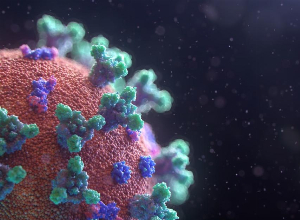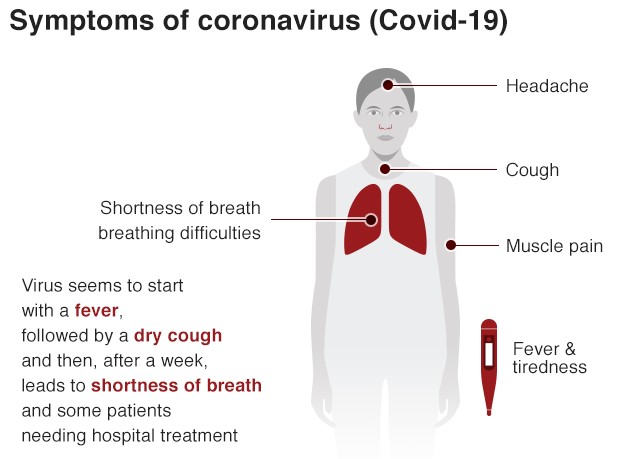Coronavirus: What do you need to know?
Published Mar 17, 2020 • By Camille Dauvergne
After the emergence of the coronavirus SARS, which was responsible for pneumonia in 2003 and MERS, responsible for severe respiratory diseases in 2012, the world is now facing a new coronavirus: SARS-CoV2. Where does this new virus come from? What are the symptoms? How can we protect ourselves? We tell you all about the Coronavirus and COVID-19 infection!

Coronavirus, COVID-19, SARS-Cov2, what does all this mean?
According to the World Health Organization (WHO), "Coronaviruses (CoV) are a large family of viruses that cause illness ranging from the common cold to more severe diseases such as Middle East Respiratory Syndrome (MERS-CoV) and Severe Acute Respiratory Syndrome (SARS-CoV)".
In December 2019, an epidemic of pneumonia with no known cause surfaced in the city of Wuhan (Hubei Province, China). On January 9, 2020, the discovery of a new coronavirus (first called 2019-nCoV and then officially SARS-Cov2) was officially announced by the Chinese health authorities and the World Health Organization (WHO). The acronym SARS-Cov2 stands for "Severe Acute Respiratory Syndrome Coronavirus 2".
This new virus is the cause of a new infectious respiratory disease called COVID-19 (for CoronaVIrus Disease 2019). Viruses and the diseases they cause, often have different names. For example, HIV is the virus that causes AIDS. In the case of the current pandemic, Cov2-SARS is the virus (coronavirus) that causes the COVID-19 infection.
Where did the coronavirus come from?
According to the Pasteur Institute, it is likely that the virus comes from an animal reservoir that has not been identified to date. Even if SARS-Cov2 is very close to a virus detected in a bat, the animal responsible for transmission to humans has not yet been identified with certainty. Several publications suggest that pangolin, a small mammal consumed in southern China, could be involved as an intermediate host between bats and humans.
Human-to-human transmission of the virus has been proven and it is estimated, to date, that in the absence of control and preventative measures, each patient could infect between 2 and 3 people.
How is the Coronavirus spread?
Coronavirus is transmitted through respiratory droplets: sputtering, sneezing, coughing, etc. Any close contact with a sick person, such as sharing the same living space, direct contact within about 3 feet or a discussion of at least 15 minutes without protection, can transmit the virus. Harvard Medical School has shared that recent studies have found that the coronavirus "can survive up to 4 hours on copper, up to 24 hours on cardboard, and up to 2 to 3 days on plastic and stainless steel" and its droplets can remain in the air for up to 3 to 4 hours before they fall, though most fall more quickly.
According to WHO, the incubation period for the COVID-19 coronavirus is generally 3 to 5 days, however, it can extend up to 14 days. During this period, the subject may be contagious: he or she may carry the virus before the onset of symptoms or at the onset of weak signals.
What are the symptoms of COVID-19?

The main symptoms are fever (or the feeling of fever), as well as cough and/or shortness of breath. In the most severe cases, the patient may experience acute respiratory distress syndrome, acute kidney failure, or even multi-visceral (multi-organ) failure, which can lead to death.
What are the precautions to follow on March 17, 2020 at 9:00 am?
General Recommendations
These are the government recommendations which are regularly updated here: https://www.usa.gov/coronavirus
On March 16th 2020, the President recommended the following measures be put in place:
- Listen to and follow the directions of your state and local authorities.
- If you feel sick, stay home. Do not go to work. Contact your medical provider.
- If your children are sick, keep them at home. Do not send them to school. Contact your medical provider.
- If someone in your household has tested positive for the coronavirus, keep the entire household at home. Do not go to work. Do not go to school. Contact your medical provider.
- If you are an older person, stay home and away from other people.
- If you are a person with a serious underlying health condition that can put you at increased risk, stay home and away from other people.
- Work or engage in schooling from home whenever possible.
- Avoid social gatherings in groups of more than 10 people.
- Avoid eating or drinking at bars, restaurants, and food courts - use drive-thru, pickup, or delivery options.
- Avoid discretionary travel, shopping trips, and social visits.
- Do not visit nursing homes or retirement or long-term care facilities unless to provide critical assistance.
In addition, the government recommends the following good practices:
- Wash your hand, especially after touching any frequently used item or surface.
- Avoid touching your face.
- Sneeze or cough into a tissue, or the inside of your elbow.
- Disinfect frequently used items and surfaces as much as possible.
In case of signs of respiratory infection (fever or feeling of fever, cough, difficulty breathing):
- If you develop symptoms such as fever, cough, and/or difficulty breathing, and have been in close contact with a person known to have COVID-19 or have recently traveled from an area with ongoing spread of COVID-19, stay home and call your healthcare provider.
- Older patients and individuals who have severe underlying medical conditions or are immunocompromised should contact their healthcare provider early, even if their illness is mild.
- If you have severe symptoms, such as persistent pain or pressure in the chest, new confusion or inability to arouse, or bluish lips or face, contact your healthcare provider or emergency room and seek care immediately. Your doctor will determine if you have signs and symptoms of COVID-19 and whether you should be tested.
- Call 911 if you have a medical emergency: If you have a medical emergency and need to call 911, notify the operator that you have or think you might have, COVID-19. If possible, put on a facemask before medical help arrives.
What is the situation in the US on March 17 at 9:00 am?
According to the CDC's site on US cases, updated on March 16, 2020 at 4 p.m., there are 3,487 confirmed cases of COVID-19 and 68 deaths.
Currently, the the President has declared that the US is in a state of National Emergency concerning the Coronavirus Disease (COVID-19) Outbreak.
Useful sites and numbers
If you’re worried about coronavirus, you can get advice and more information at coronavirus.gov.
For information about outbreaks in your area, consult you state and local health departments here: CDC - State & Territorial Health Department Websites
If you need medical help right now, call 911. Notify the operator that you have or think you may have COVID-19.
2 comments
You will also like

What are the dangers associated with the over-the-counter sale of certain medicines?
Dec 19, 2020 • 6 comments

 Facebook
Facebook Twitter
Twitter



